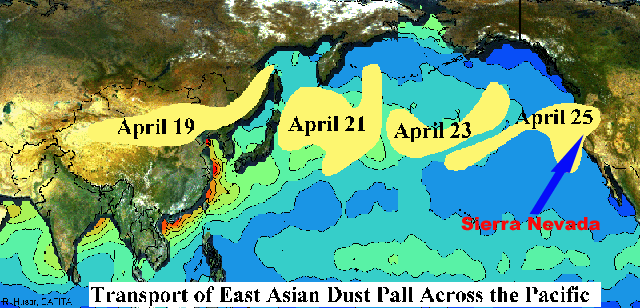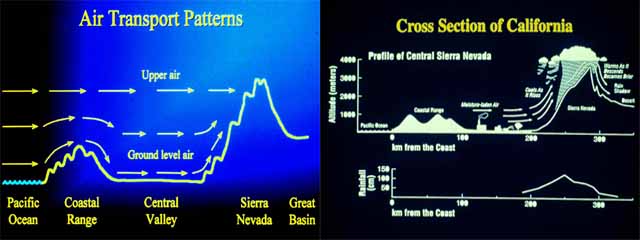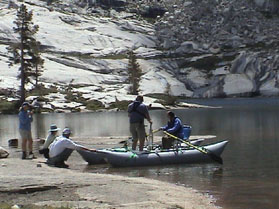Sierra Nature Notes, Volume 4, May 2004
Airborne
Pollutants in National Parks: Sequoia Park joins Large Study
Effort
Judy Rocchio
Air Quality Program Coordinator
Pacific West Region
National Park Service
From sources as far away as Europe and Asia, some of the world’s most toxic persistent chemicals are carried on air masses and are being deposited in high elevation and high latitude ecosystems in the Western United States and Alaska, including Sequoia National Park. Dr. Dixon Landers, USEPA Western Ecology Division, is the lead scientist on a multi-disciplinary research team involving three other federal agencies and two major universities working on the Western Airborne Contaminants Assessment Project (WACAP). The amount of toxic chemical deposition, past and present, and the possible environmental effects of these persistent pollutants in national parks are not known. This project assesses the concentrations of contaminants in snow, sediment, lake water, vegetation and fish to determine when and how rapidly these compounds have impacted these environments. Eight parks at high elevation and/or high latitude have been or will be sampled between 2003 and 2006, including Sequoia, Rocky Mountain, Glacier, Olympic, Mount Rainier, Denali, Noatak, and Gates of the Arctic National Parks.
 |
| Figure
1 Pollution from afar: Trans-Pacific dust movement from the Gobi Desert to North America. Positions of the first in a series of dust emissions from Asia are indicated by dates between April 17 and 25, 1998. The data were acquired from SeaWiFs, GMS, and three GOES satellites. (modified from Husar, 1998). Husar, R.B; JGR-ATM. 106 (D16): 18317-18330 AUG 27 2001 |
Arctic and alpine lakes in North America intercept major air pathways from
Eurasia. While the specific sources of airborne contaminants affecting national
parks in the U.S. are currently unknown, other studies have shown that air
masses leave the Asian coast heading east to the Arctic and North American
West Coast across the Pacific ocean in just a few days (see Figure 1). These
areas burn great amounts of coal (a major source of mercury) and many Asian
countries still use pesticides (like DDT to control malaria-carrying mosquitoes).
Polychlorintaed biphenyls (PCBs) continue to be emitted from industrial sites
in Russia, and abandoned industrial sites in Japan, Europe, and the USA.
Formerly used defense sites are commonly local sources of PCBs in arctic
North America. DDT was used as a fog to control mosquitoes on Alaskan military
bases before its use was curtailed, but residues continue to be found. The
limited research conducted to date indicates that airborne contaminants may
be accumulating in cold environments such as lake basins in U.S. National
Parks at high elevations or northern latitudes.
 |
| Air Transport Patterns into the Sierra Nevada from both trans-Pacific
winds and local patterns from the Central Valley. From James Seiber Case study: monitoring of air toxics transport and deposition in the Sierra Nevada Sieber,
James; 2001 Presentation at National Park Service Air Toxic Workshop,
Seattle, WA |
Research in the last couple of decades show that Persistent Organic Pollutants (POPs), semi-volatile organic compounds (SOCs), and mercury (Hg) are persistent, can travel long distances in the atmosphere, and concentrate in cold environments. These compounds can re-emit to the atmosphere from relatively warm environments until they finally deposit and remain in colder environments. This process is known as cold-condensation. These materials are most effectively removed from the atmosphere by snow and fog, and less so by rain or dry deposition. We also know these toxic compounds biomagnify at each higher level in the food chain, and many of the organic compounds take up long-term residence in fatty tissues of animals.
 |
| WACAP Scientists Sampling in SEKI |
In August 2003 WACAP scientists began their first summer sampling season in Sequoia National Park at Emerald and Pear Lakes watersheds (9,500 feet or 2,900 meters). The researchers sampled lake water, lake sediment, fish, soils, and lichen to determine the quantity and types of contaminants being deposited. Final results of these analyses are not yet in, however POPs, SOCs and mercury are known to have various health effects on fish, wildlife and humans depending on the concentrations at which they are present. At high levels some of these effects can include tumors and cancer, reduced immune functions, reduced reproductive success, inhibited endocrine systems and neurotoxic effects such as decreased learning, reduced memory, and impaired movement capabilities. In addition, there is speculation that some pollutants contribute to increased mortality in the endangered mountain yellow-legged frog.
Laboratory analysis of the field samples collected during the WACAP project will include 85 long-lived, organic pollutants, including DDT and other chemicals banned in the United States and 49 metals including mercury. Very early data results from last summer’s sampling at Sequoia NP show current-use and banned SOCs are present in water, snow, and lichen at the two watersheds sampled. The initial sample analysis indicates that Sequoia NP likely has a broader range of these compounds than does Rocky Mountain NP. As the interdisciplinary team of scientists including aquatic ecologists, fisheries biologists, atmospheric scientists, chemists and botanists work together over the next 2 years to interpret and integrate project results, a clearer understanding of contaminant impacts to high elevation, and high latitude ecosystems will result. The project is expected to provide recommendations on how to proceed from the findings and whether to conduct additional future monitoring to track the increase or decrease in concentrations of these toxic chemicals in various components of park ecosystems.
Dealing with the control of toxic airborne contaminants will require international solutions. Earlier this year (February 2004) France became the 50th country to ratify the 2001 Stockholm Convention on Persistent Organic Pollutants setting in motion the process to turn the treaty into binding international law by this Spring. The treaty greatly restricts the international production and use of the “dirty dozen” chemicals (see Table 1) and allows for consideration of reducing or banning production and use of additional chemicals suspected to pose a threat to ecosystems and human health.
| Table 1. Dirty Dozen Persistent Organic Pollutants (POPs) | |
| DDT | Polychlorinated Biphenyls (PCBs) |
| Dioxin | Aldrin |
| Chlordane | Dieldrin |
| Endrin | Heptachlor |
| Mirex | Toxaphene |
| Hexachlorobenzene | Furans |
If remote, relatively pristine areas of the United States are being affected
by, local, regional, or long distance transpacific transport of persistent
toxic airborne contaminants, studies in Sequoia and other National Parks
may help provide information that could assist policymakers in proposing
solutions to these problems in the future. National Parks as remote, ecologically
sensitive sites may become the bellwether to understand the environmental
impact of these toxic compounds in North America.
Further Reading
Western
Airborne Contaminants Assessment Project (WACAP) website
The
Asian Dust Events of April 1998 Examines the event and the wind
patterns carrying the dust world wide.
Understanding
Smog in the Sierra
by E. F. van Mantgem Meteorological
station operator for Sequoia and Kings Canyon National Parks.
Air
Quality in Yosemite National Park Status
of air quality research and monitoring in Yosemite.
National
Parks and Conservation Association: Code
Red: America's Five Most Polluted National Parks Report
on recent (2004) EPA report on air quality in National Parks and the west.
Spatial Tests of the Pesticide Drift, Habitat
Destruction, UV-B, and Climate-Change Hypotheses
for California Amphibian Declines (PDF file)
CARLOS DAVIDSON, H. BRADLEY SHAFFER, AND MARK R. JENNINGS. Technical paper
looking at possible role of air pollution on amphibian decline in the Sierra.
Our Founder Questions? Go to About Our New Site |
Masthead
Photo from: |